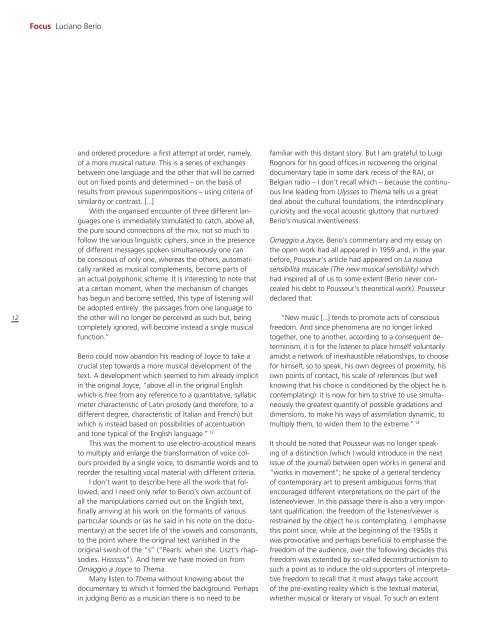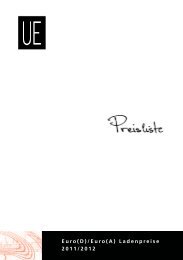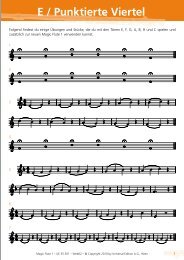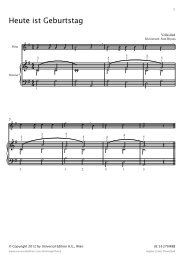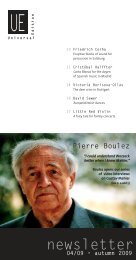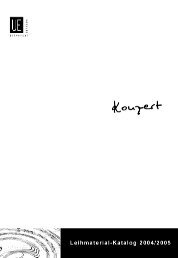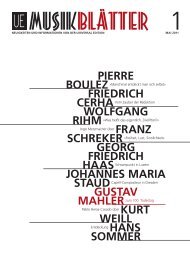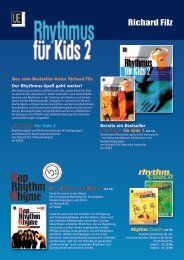Download a PDF file - Universal Edition
Download a PDF file - Universal Edition
Download a PDF file - Universal Edition
Create successful ePaper yourself
Turn your PDF publications into a flip-book with our unique Google optimized e-Paper software.
12<br />
focus Luciano Berio<br />
and ordered procedure: a first attempt at order, namely,<br />
of a more musical nature. This is a series of exchanges<br />
between one language and the other that will be carried<br />
out on fixed points and determined – on the basis of<br />
results from previous superimpositions – using criteria of<br />
similarity or contrast. [...]<br />
With the organised encounter of three different languages<br />
one is immediately stimulated to catch, above all,<br />
the pure sound connections of the mix, not so much to<br />
follow the various linguistic ciphers, since in the presence<br />
of different messages spoken simultaneously one can<br />
be conscious of only one, whereas the others, automatically<br />
ranked as musical complements, become parts of<br />
an actual polyphonic scheme. It is interesting to note that<br />
at a certain moment, when the mechanism of changes<br />
has begun and become settled, this type of listening will<br />
be adopted entirely: the passages from one language to<br />
the other will no longer be perceived as such but, being<br />
completely ignored, will become instead a single musical<br />
function.”<br />
Berio could now abandon his reading of Joyce to take a<br />
crucial step towards a more musical development of the<br />
text. A development which seemed to him already implicit<br />
in the original Joyce, “above all in the original English<br />
which is free from any reference to a quantitative, syllabic<br />
meter characteristic of Latin prosody (and therefore, to a<br />
different degree, characteristic of Italian and French) but<br />
which is instead based on possibilities of accentuation<br />
and tone typical of the English language.” 13<br />
This was the moment to use electro-acoustical means<br />
to multiply and enlarge the transformation of voice colours<br />
provided by a single voice, to dismantle words and to<br />
reorder the resulting vocal material with different criteria.<br />
I don’t want to describe here all the work that followed,<br />
and I need only refer to Berio’s own account of<br />
all the manipulations carried out on the English text,<br />
finally arriving at his work on the formants of various<br />
particular sounds or (as he said in his note on the documentary)<br />
at the secret life of the vowels and consonants,<br />
to the point where the original text vanished in the<br />
original swish of the “s” (“Pearls: when she. Liszt’s rhapsodies.<br />
Hissssss”). And here we have moved on from<br />
Omaggio a Joyce to Thema.<br />
Many listen to Thema without knowing about the<br />
documentary to which it formed the background. Perhaps<br />
in judging Berio as a musician there is no need to be<br />
familiar with this distant story. But I am grateful to Luigi<br />
Rognoni for his good offices in recovering the original<br />
documentary tape in some dark recess of the RAI, or<br />
Belgian radio – I don’t recall which – because the continuous<br />
line leading from Ulysses to Thema tells us a great<br />
deal about the cultural foundations, the interdisciplinary<br />
curiosity and the vocal acoustic gluttony that nurtured<br />
Berio’s musical inventiveness.<br />
Omaggio a Joyce, Berio’s commentary and my essay on<br />
the open work had all appeared in 1959 and, in the year<br />
before, Pousseur’s article had appeared on La nuova<br />
sensibilità musicale (The new musical sensibility) which<br />
had inspired all of us to some extent (Berio never concealed<br />
his debt to Pousseur’s theoretical work). Pousseur<br />
declared that:<br />
“New music [...] tends to promote acts of conscious<br />
freedom. And since phenomena are no longer linked<br />
together, one to another, according to a consequent determinism,<br />
it is for the listener to place himself voluntarily<br />
amidst a network of inexhaustible relationships, to choose<br />
for himself, so to speak, his own degrees of proximity, his<br />
own points of contact, his scale of references (but well<br />
knowing that his choice is conditioned by the object he is<br />
contemplating): it is now for him to strive to use simultaneously<br />
the greatest quantity of possible gradations and<br />
dimensions, to make his ways of assimilation dynamic, to<br />
multiply them, to widen them to the extreme.” 14<br />
It should be noted that Pousseur was no longer speaking<br />
of a distinction (which I would introduce in the next<br />
issue of the journal) between open works in general and<br />
“works in movement”; he spoke of a general tendency<br />
of contemporary art to present ambiguous forms that<br />
encouraged different interpretations on the part of the<br />
listener/viewer. In this passage there is also a very important<br />
qualification: the freedom of the listener/viewer is<br />
restrained by the object he is contemplating. I emphasise<br />
this point since, while at the beginning of the 1950s it<br />
was provocative and perhaps beneficial to emphasise the<br />
freedom of the audience, over the following decades this<br />
freedom was extended by so-called deconstructionism to<br />
such a point as to induce the old supporters of interpretative<br />
freedom to recall that it must always take account<br />
of the pre-existing reality which is the textual material,<br />
whether musical or literary or visual. To such an extent


